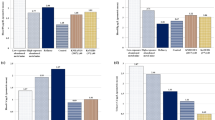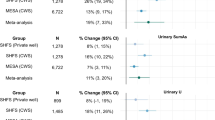Abstract
In order to evaluate the degree of arsenic (As) exposure and the factors influencing urinary As excretion and metabolism, 192 workers from a steel and iron smelting plant, with different type of work in production such as roller, steel smelting, iron smelting and metallic charge preparation, were recruited. Information about characteristics of each subject was obtained by questionnaire and inorganic As (iAs), monomethylarsonic acid (MMA), dimethylarsinic acid (DMA) in urine were determined. The results showed that steel smelters had significantly higher concentrations of DMA and total As (TAs) than rollers and metallic charge preparation workers, and iron and steel smelters had a higher value of primary methylation index and lower proportion of the iAs (iAs%) than rollers and metallic charge preparation workers. In steel smelters, urinary As level exceeded the biological exposure index (BEI) limit for urinary As of 35 μg/l by 65.52%, and higher than metallic charge preparation workers (35.14%). The individuals consumed seafood in recent 3 days had a higher TAs than the individuals without seafood consumption. Multivariate logistic regression analysis showed that different jobs, taken Chinese medicine of bezoar and seafood consumption in recent 3 days were significantly associated with urinary TAs exceeded BEI limit value 35 μg/l. Our results suggest that workers in steel and iron smelting plant had a lower level of As exposure, and seafood consumption and taking Chinese medicine of bezoar also could increase the risk of urinary TAs exceeded BEI limit value.
This is a preview of subscription content, access via your institution
Access options
Subscribe to this journal
Receive 6 print issues and online access
$259.00 per year
only $43.17 per issue
Buy this article
- Purchase on Springer Link
- Instant access to full article PDF
Prices may be subject to local taxes which are calculated during checkout
Similar content being viewed by others
References
IARC. Some Metals and Metallic Compounds (IARC Monographs on the Evaluation of Carcinogenic Risk to Humans, Vol. 84. International Agency of for Research on Cancer: Lyon, France. 2004.
Vahter M, Friberg L, Rahnster B, Nygren B . Airborne arsenic and urinary excretion of metabolites of inorganic arsenic among smelter workers. Int Arch Occup Environ Health 1986; 57: 79–91.
WHO. Arsenic and Arsenic Compounds. Environmental Health Criteria 224. World Health Organization: Geneva, Switzerland. 2001.
Hwang YH, Lee ZY, Wang JD, Hsueh YM, Lu IC, Yao WL . Monitoring of arsenic exposure with speciated urinary inorganic arsenic metabolites for ion implanter maintenance engineers. Environ Res 2002; 90: 207–216.
Lubin JH, Moore LE, Fraumeni JF, Jr, Cantor KP . Respiratory cancer and inhaled inorganic arsenic in copper smelters workers: a linear relationship with cumulative exposure that increases with concentration. Environ Health Perspect 2008; 116: 1661–1665.
Park D, Yang H, Jeong J, Ha K, Choi S, Kim C et al. A comprehensive review of arsenic levels in the semiconductor manufacturing industry. Ann Occup Hyg 2010; 54: 869–879.
Vahter M, Concha G . Role of metabolism in arsenic toxicity. Pharmacol Toxicol 2001; 89: 1–5.
Le XC, Cullen WR, Reimer KJ . Determination of urinary arsenic and impact of dietary arsenic intake. Talanta 1993; 40: 185–193.
Ma M, Le XC . Effects of arsenosugar ingestion on urinary arsenic speciation. Clin Chem 1998; 14: 539–550.
Francesconi KA, Tangaard N, McKenzie CJ, Goessler W . Arsenic metabolites in human urine after ingestion of an arsenosugar. Clin Chem 2002; 48: 92–101.
Lin TH, Huang YL, Wang MY . Arsenic species in drinking water, hair, fingernails, and urine of patients with blackfood disease. J Toxicol Environ Health 1998; 53: 85–93.
Wilhelm M, Pesch B, Wittsiepe J, Jakubis P, Miskovic P, Keegan T et al. Comparison of arsenic levels in fingernails with urinary As species as biomarkers of arsenic exposure in residents living close to a coal-burning power plant in Prievidza District, Slovakia. J Expo Anal Environ Epidemiol 2005; 15: 89–98.
Lovreglio P, D'Errico MN, Gilberti ME, Drago I, Basso A, Apostoli P et al. The influence of diet on intra and inter-individual variability of urinary excretion of arsenic species in Italian healthy individuals. Chemosphere 2012; 86: 898–905.
Marcos R, Martínez V, Hernández A, Creus A, Sekaran C, Tokunaga H et al. Metabolic profile in workers occupationally exposed to arsenic: role of GST polymorphisms. J Occup Environ Med 2006; 48: 334–341.
ACGIH. American Conference of Governmental Industrial Hygienists. Threshold limit values for chemical substances and physical agents and biological exposure indices. Cincinnati, OH, USA. 2000.
WHO. Biological Monitoring of Chemical Exposure in the Workplace, vol. 1. World Health Organization: Geneva, Switzerland. 1996.
Xu Y, Wang Y, Li X, He M, Xue P, Fu J et al. Variations in arsenic methylation capacity and oxidative DNA lesions over a 2-year period in a high arsenic-exposed population. Int Arch Occup Environ Health 2009; 82: 251–258.
Sun G, Xu Y, Li X, Jin Y, Li B, Sun X . Urinary arsenic metabolites in children and adults exposed to arsenic in drinking water in Inner Mongolia, China. Environ Health Perspect 2007; 115: 648–652.
Horing CJ, Horing PH, Lin SC, Tsai JL, Lin SR, Tzeng CC . Determination of urinary beryllium, arsenic, and selenium in steel production workers. Biol Trace Elem Res 2002; 88: 235–246.
Afridi HI, Kazi TG, Kazi NG, Jamali MK, Arain MB, Sirajuddin et al. Evaluation of arsenic, cobalt, copper and manganese in biological Samples of Steel mill workers by electrothermal atomic absorption Spectrometry. Toxicol Ind Health 2009; 25: 59–69.
Buchet JP, Lauwerys R, Roels H . Comparison of several methods for the determination of arsenic compounds in water and in urine. Int Arch Occup Env Health 1980; 4: 11–29.
Vahter M, Envall J . In vivo reduction of arsenate in mice and rabbits. Environ Res 1983; 32: 14–24.
Hayakawa T, Kobayashi Y, Cui X, Hirano S . A new metabolic pathway of arsenite: arsenic-glutathione complexes are substrates for human arsenic methyltransferase Cyt19. Arch Toxicol 2005; 79: 183–191.
Del Razo LM, García-Vargas GG, Vargas H, Albores A, Gonsebatt ME, Montero R et al. Altered profile of urinary arsenic metabolites in adults with chronic arsenicism. A pilot study. Arch Toxicol 1997; 71: 211–217.
Tseng CH . A review on environmental factors regulating arsenic methylation in human. Toxicol Appl Pharmacol 2009; 35: 338–350.
Hopenhayn-Rich C, Smith AH, Goeden HM . Human studies do not support the methylation threshold hypothesis for the toxicity of inorganic arsenic. Environ Res 1993; 60: 161–177.
Hopenhayn-Rich C, Biggs ML, Kalman DA, Moore LE, Smith AH . Arsenic methylation patterns before and after changing from high to lower concentrations of arsenic in drinking water. Environ Health Perspect 1996; 104: 1200–1207.
Concha G, Nermell B, Vahter MV . Metabolism of inorganic arsenic in children with chronic high arsenic exposure in northern Argentina. Environ Health Perspect 1998; 106: 355–359.
Hata A, Endo Y, Nakajima Y, Ikebe M, Ogawa M, Fujitani N et al. HPLC-ICP-MS speciation analysis of arsenic in urine of Japanese subjects without occupational exposure. J Occup Health 2007; 49: 217–223.
Soleo L, Lovreglio P, Iavicoli S, Antelmi A, Drago I, Basso A et al. Significance of urinary arsenic speciation in assessment of seafood ingestion as the main source of organic and inorganic arsenic in a population resident near a coastal area. Chemosphere 2008; 73: 291–299.
Vimercati L, Carrus A, Sciannamblo G, Caputo F, Minunni V, de Nichilo G et al. A study of factors influencing urinary arsenic excretion in exposed workers. Int J Environ Health Res 2009; 19: 369–377.
Hsueh YM, Ko YF, Huang YK, Chen HW, Chiou HY, Huang YL et al. Determinants of inorganic arsenic methylation capability among residents of the Lanyang Basin, Taiwan: arsenic and selenium exposure and alcohol consumption. Toxicol Lett 2003; 137: 49–63.
Gomez-Rubio P, Roberge J, Arendell L, Harris RB, O'Rourke MK, Chen Z et al. Association between body mass index and arsenic methylation efficiency in adult women from southwest U.S. and northwest Mexico. Toxicol Appl Pharmacol 2011; 252: 176–182.
Huang YK, Tseng CH, Huang YL, Yang MH, Chen CJ, Hsueh YM . Arsenic methylation capability and hypertension risk in subjects living in arseniasis–hyperendemic areas in southwestern Taiwan. Toxicol Appl Pharmacol 2007; 218: 135–142.
Li L, Ekstrom EC, Goessler W, Lonnerdal B, Nermell B, Yunus M et al. Nutritional status has marginal influence on the metabolism of inorganic arsenic in pregnant Bangladeshi women. Environ Health Perspect 2008; 116: 315–321.
Lindberg AL, Ekstrom EC, Nermell B, Rahman M, Lonnerdal B, Persson LA et al. Gender and age differences in the metabolism of inorganic arsenic in a highly exposed population in Bangladesh. Environ Res 2008; 106: 110–120.
Hsueh YM, Hsu MK, Chiou HY, Yang MH, Huang CC, Chen CJ . Urinary arsenic speciation in subjects with or without restriction from seafood dietary intake. Toxicol Lett 2002; 133: 83–91.
Acknowledgements
This work was supported by the National Natural Science Foundation of China (NSFC) (81072244).
Author information
Authors and Affiliations
Corresponding author
Ethics declarations
Competing interests
The authors declare no conflict of interest.
Rights and permissions
About this article
Cite this article
Shuhua, X., Qingshan, S., Fei, W. et al. The factors influencing urinary arsenic excretion and metabolism of workers in steel and iron smelting foundry. J Expo Sci Environ Epidemiol 24, 36–41 (2014). https://doi.org/10.1038/jes.2013.2
Received:
Accepted:
Published:
Issue Date:
DOI: https://doi.org/10.1038/jes.2013.2
Keywords
This article is cited by
-
Changes in urinary arsenic species and methylation capacity in original arsenic exposure cohort after water quality improvement
Environmental Geochemistry and Health (2020)
-
Metal Biomonitoring and Comparative Assessment in Urine of Workers in Lead-Zinc and Steel-Iron Mining and Smelting
Biological Trace Element Research (2019)
-
Arsenic Metabolites and Methylation Capacity Among Individuals Living in a Rural Area with Endemic Arseniasis in Inner Mongolia, China
Biological Trace Element Research (2016)



